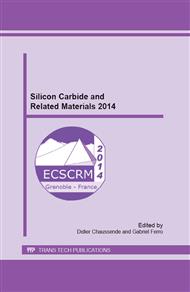p.81
p.85
p.90
p.96
p.100
p.104
p.108
p.115
p.121
Characterization of Second-Phase Inclusion in Silicon Carbide Powders
Abstract:
A specific transition metal is used as a dopant element in silicon carbide powders to create the compensation effect. According to ab-initio simulation, vanadium, chromium, and manganese-induced compensation decrease the lifetime of the acceptor carrier and cause higher resistance when boron is the main impurity. Since the silicon carbide lattice has low solubility, excess metal precipitates on the surface of powders, particularly on the grain boundaries. The compositions of matrix and precipitation in the powders reveal obvious differences between the two areas. The X-ray diffraction (XRD) pattern shows the structure of VSi2, which indicates the existence of a second phase. Dual-beam focused ion beam (DBFIB) is used to further analyze the geography inside the powders. A cross-section view by DBFIB shows a second phase in the grains with a composition similar to that in the grain boundary. Metal-doped silicon carbide powders are used as starting materials to conduct crystal growth with better dopant element distribution.
Info:
Periodical:
Pages:
100-103
Citation:
Online since:
June 2015
Authors:
Keywords:
Price:
Сopyright:
© 2015 Trans Tech Publications Ltd. All Rights Reserved
Share:
Citation:


